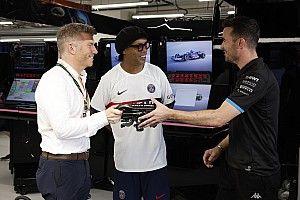Formula 1 and Asia: What are the next steps?
James Allen reports from the FIA Sport Conference in Manila, where the subjects ranged from getting another Asian driver into F1, to building the sport there from the grass roots.

Photo by: Sutton Images

Motorsport Blog
Motorsport Blog
Formula 1 is the pinnacle of motorsport, as we are often told. But to get to the pinnacle you have to pass through a journey and in a competitive environment like motorsports that means overcoming significant hurdles.
Those hurdles are even greater for drivers coming from outside Europe, as was spelled out quite plainly at the FIA Sport Conference in Manila.
For F1 to market itself as the best drivers in the world, it really needs to have the best drivers in the world, who have come up through the ranks from countries around the globe. Today it cannot really say that.
The cost of climbing the ladder is prohibitively high and access to the feeder series is limited, especially in regions like Asia. And yet if Asia could produce a quality driver, the sport would have greater chance of thriving in the region.
F1 CEO Chase Carey appeared in a panel discussion on Day 1 of the conference with Asian drivers Alex Yoong and Marlon Stockinger, which looked at how to find a way for the halo effect of F1 to benefit the grassroots of motorsport in the region.
“Do you want the best Asian drivers to get to the top of the sport? Or do you want to help Asian motor sport? Because those are two very different things,” Young explained.
“At the moment, if you want the best drivers to get to the top of the sport, you take young Asian drivers and you send them to Europe when they are nine or ten years old, and you leave them there with their families, because you have to grow up in that culture, amongst that level of competition.
“Eventually Formula 3 and Formula 4, hopefully in the future, will be strong enough in Asia that drivers can stay here and learn the right foundation so that when they do go to Europe they can be competitive straight away... If you improve local motorsport you have more kids coming through.”
It was very clear from the delegates that F1 needs to do more to bridge the elite and grassroots levels of the sport and to make sure the halo effect of F1 works to encourage youngsters to take the sport up, rather than sucking all the oxygen out of the motorsport ecosystem in an emerging market like Malaysia or Singapore.
As well as speaking in the opening session, Carey was notable by his presence at the second session in the hall about growing the grassroots of motorsport through esports, karting and a new entry level series called CrossCar.
For Carey, who was new to F1 in the last couple of years, it was an opportunity to see the extent of the ladder that goes into finding and channeling talent. He has recently concluded a deal with the FIA to bring F3 into the F1 support bill along with F2 (formerly GP2), thus completing the pyramid from F4 to F1. But his experience in Manila will have made him realise that F1 needs to play its part in making the sport strong everywhere so the best talent rises to the top.
“It’s about developing a sport at a grassroots level,” said Carey. “At the end of the day for Formula 1, we want the 20 best drivers in the world, but we also want drivers from around the world to have the opportunity to get involved through grassroots efforts.
“I think again, it is about spectators having visibility – there are sports that are not going to have as much participation.
“Billions play soccer, there are not billions who race. But there is a fascination with it, people love the sport in a lot of different ways and are engaged in a lot of different ways.”
Carey also spoke about the recent F1 demonstration in Hanoi, Vietnam and whether that indicated a Vietnam GP could be on the cards.
“Certainly Vietnam is one of those countries that is continuing to become a bigger and more exciting place – for tourism, business or otherwise,” he said. “We want to be in what we call destination cities, destination countries – places that can capture the world’s imagination, and Vietnam is one of those places.”
He also confirmed that F1 is considering a second Grand Prix in China, having identified it as a market with a high-level of potential fans.
“Sure. Right now, we’re hoping to have a second Grand Prix in the US. I think countries of that size and scale... That’s important. Our focus is that we want to make sure that the events we have, we want to make as strong as they can be – so it is quality over quantity.”
Be part of Motorsport community
Join the conversationShare Or Save This Story
Subscribe and access Motorsport.com with your ad-blocker.
From Formula 1 to MotoGP we report straight from the paddock because we love our sport, just like you. In order to keep delivering our expert journalism, our website uses advertising. Still, we want to give you the opportunity to enjoy an ad-free and tracker-free website and to continue using your adblocker.



















Top Comments